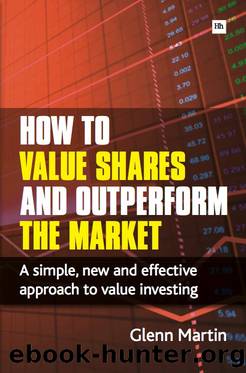How to Value Shares and Outperform the Market: A Simple, New and Effective Approach to Value Investing by Glenn martin

Author:Glenn martin [martin, Glenn]
Language: eng
Format: epub
Tags: Business & Economics, Investments & Securities, General
ISBN: 9780857191779
Google: C1kg11T0HqcC
Publisher: Harriman House Limited
Published: 2011-11-07T00:08:58.558522+00:00
To calculate this value, you first need to calculate the end-period FTSE100 yield. This is the projected FTSE100 dividend yield at the end of the five-year period. It takes into account the projected inflation rate for the end of the period.
The calculations for this yield in ShareMaestro are proprietary and complex. The following formula uses the projected end-period inflation rate and produces a similar result to the one produced by ShareMaestro.
Entry in cell A21: End-period FTSE100 yield %
Formula entry in B21: =+(B10/10.5*3)+2.4
This formula might need to be altered if the tax treatment of dividends for basic-rate taxpayers were changed. Since 1997, the dividends actually paid to shareholders by companies are deemed to be net of the basic rate of personal Income Tax.
The end-period share dividend yield is then calculated by adjusting the end-period FTSE100 dividend yield in accordance with the ratio of the target dividend cover to the projected actual end-period dividend cover for the share.
This calculation assumes that by the end of the five-year period the shareâs future sustainable growth will be in line with that of the FTSE100. However, as well as dividend cover, a shareâs prospective long-term sustainable dividend growth will influence the dividend yield. The market will accept a relatively low current dividend yield if it expects the dividend to increase strongly. Conversely, the market will require a higher current dividend yield if it expects the dividend to remain static or to fall.
You can adjust the end-period dividend yield by adjusting the target dividend cover. Consequently, if you expect the shareâs dividend growth to significantly exceed that of the market in Years 5 to 10, you should reduce the target dividend cover (B7) accordingly. Conversely, if you expect the shareâs dividend growth to fall significantly short of the market in Years 5 to 10, you should increase the target dividend cover (B7) accordingly.
For example, if you expect that, at the end of the five-year period, the shareâs dividend growth (with dividend cover remaining unchanged) would be so strong as to produce double the dividend at the end of the next five years than if it merely matched the FTSE100 dividend growth, you would halve the target dividend cover input in B7.
The end-period share dividend yield (E6) is calculated by multiplying the end-period FTSE100 dividend yield (B21) by the target dividend cover (B7) divided by the projected end-period share dividend cover (B8).
Formula entry in E6: =B21*B7/B8
Download
This site does not store any files on its server. We only index and link to content provided by other sites. Please contact the content providers to delete copyright contents if any and email us, we'll remove relevant links or contents immediately.
Zero to IPO: Over $1 Trillion of Actionable Advice from the World's Most Successful Entrepreneurs by Frederic Kerrest(4077)
Machine Learning at Scale with H2O by Gregory Keys | David Whiting(3666)
Harry Potter and the Goblet Of Fire by J.K. Rowling(3619)
Never by Ken Follett(3550)
Ogilvy on Advertising by David Ogilvy(3353)
Shadow of Night by Deborah Harkness(3184)
The Man Who Died Twice by Richard Osman(2824)
Book of Life by Deborah Harkness(2727)
My Brilliant Friend by Elena Ferrante(2707)
How Proust Can Change Your Life by Alain De Botton(2621)
0041152001443424520 .pdf by Unknown(2613)
Will by Will Smith(2595)
The Tipping Point by Malcolm Gladwell(2566)
How to Pay Zero Taxes, 2018 by Jeff A. Schnepper(2508)
Purple Hibiscus by Chimamanda Ngozi Adichie(2505)
Hooked: A Dark, Contemporary Romance (Never After Series) by Emily McIntire(2428)
Rationality by Steven Pinker(2159)
Borders by unknow(2122)
Daughter of Smoke and Bone by Laini Taylor(2086)
